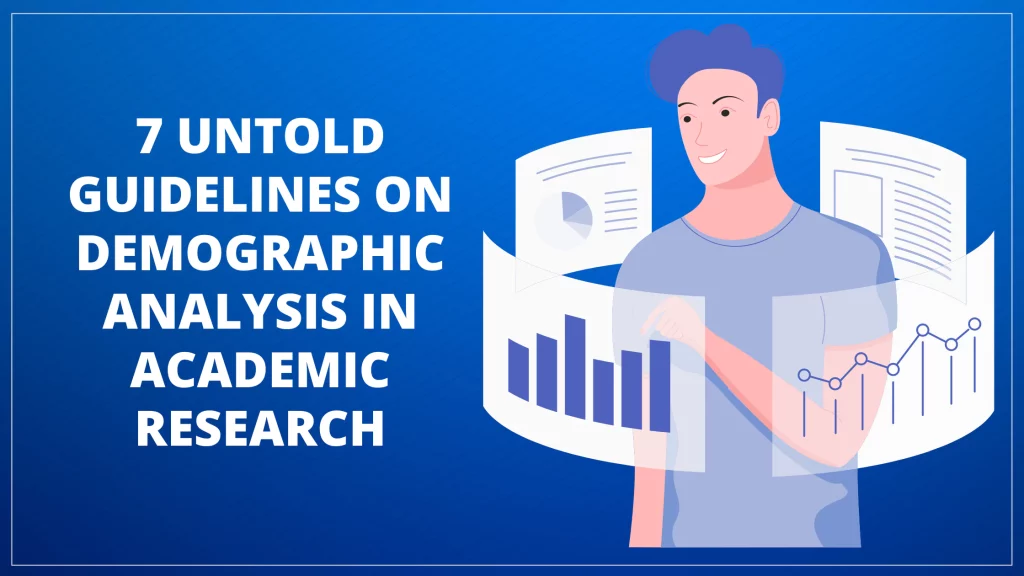If you are a student of sociology, you must know what demographic analysis is and how to conduct it. What? Do you not know how to conduct it? It is sad that you do not know about the guidelines for doing this analysis. Well, there is no need to worry. As you here reading this article, you will get all the information about this analysis and how to do it. However, before moving on to the guidelines, let’s explain what demography is in academic research.
What Is Demography In Academic Research?
Demography is a combination of two Greek words. One is “Demos” meaning people, and the other is “Graphos” meaning to write something. According to the UN Multilingual Demographic Dictionary, it is defined as follows:
“Demography is the study of human populations, primarily with respect to their size, structure, and development over time.”
In simple words, demography is the study of the changes brought up by the birth and death rates in a population. The effect of migration on the human population is also considered in this study. Demography at least focuses on the following five components of the human population:
- Size
- Distribution
- Composition
- Components of population change
- Consequences of population or demographic change
7 Untold Guidelines On Demographic Analysis
Demographic analysis is the study of how certain changes in a population have changed the face of the population. It looks deeply at the components of the change and discusses the consequences if the change continues to happen. Nevertheless, the main topic is to talk about the 7 untold guidelines in this analysis. Knowing these guidelines will help you a lot in conducting this analysis effectively. Hence, a brief description of the guidelines is as follows:
1. Define The Purpose Of Your Analysis
First things first, you need to define the purpose of your demographic analysis first. It means that you must be clear about what you intend to search for or unfold in your analysis. What change do you want to analyse and answer in your analysis? When you define this question, the rest of the work becomes easy. So, first, define your purpose.
2. Collect The Demographic Data
Demographic data is information about humans in a population. This information can be about their age, sex, or place of residence. It can also include socioeconomic data, e.g., the occupation of the respondents and their income. So, when you have defined the purpose of your analysis, start collecting the data that serves that purpose. It is important that the data you collect must be relevant to your analysis purpose.
3. Clean The Data From Errors
Once you have collected the data, there are many possibilities for errors in it. Hence, the next guideline is that you must clean the data before using it for analysis purposes. During the cleaning stage, you must take care of all the outliers, duplications, and missing values in the data. However, if you feel like you cannot do this, take help from top academic writers.
4. Classify The Demographic Data
According to the level of measurement, demographic data can be classified into several classifications. Classifying the data helps a lot in choosing the right method for the demographic analysis. The four classifications that are used most commonly are ordinal, nominal, interval, and ratio. So, classify your data into any of these classifications.
5. Choose The Analysis Method
Here comes the most important guideline of the whole analysis. Choosing the right analysis method is very crucial and important. The reason is that if you choose the right method, your results are applicable and effective. Otherwise, the analysis will not be successful. Mostly, descriptive analysis methods are used for demographic analysis. However, sometimes, inferential methods can also be employed.
6. Perform The Analysis
Finally, the step you have been waiting for has arrived. After choosing the right analysis method, perform the analysis. Calculate all the things required, i.e., mean, median, mode, or standard variation. It is important to follow all the procedural steps of the analysis when you work on demographic analysis. If you miss one step accidentally, all your results may get altered, and you may not be able to address the causes of demographic changes.
7. Share The Analysis Results
The last guideline is about sharing the results of your analysis. After you have conducted your analysis, you have all the causes for the specific change in the population in hand. You also know the consequences if the change continues to happen. Hence, the next part of the analysis is to share the results with the concerned authorities.
Conclusion
Conclusively, demographic analysis is an analysis that explains the causes of a particular change in the humans of a population. It also explains the consequences of the change if it continues to happen. However, it can only be done if you conduct the analysis correctly. To conduct the analysis right, you must follow all the 7 guidelines mentioned above.

